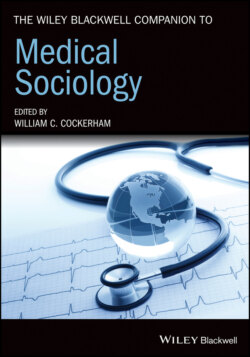Читать книгу The Wiley Blackwell Companion to Medical Sociology - Группа авторов - Страница 62
Culture and Illness Behavior
ОглавлениеAs mentioned earlier, illness behavior refers to the activity undertaken by a person who feels ill for the purpose of defining the illness and seeking a solution (Kasl and Cobb 1966). What people do when they begin to feel unwell, the manner in which people react to symptoms, and the meaning they attach to symptoms vary across cultures.
Reviewing the work of Edward Suchman (1964, 1965) on illness behavior and ethnicity, Geertsen and his colleagues (1975) concluded that there was indeed an association between the two phenomena. They found that “Group closeness and exclusivity increases the likelihood” of a person responding to a health problem “in a way that is consistent with his subcultural background” (1975: 232). Further detailed data on the correlation between ethnicity and illness behavior was reported by, among others, Robertson and Heagarty (1975); Kosa and Zola (1975); and by Sanborn and Katz (1977) who found significant cultural variations in the perception of symptoms. In fact, the relative saturation of the literature regarding the ethnicity-illness behavior link was already manifested in Mechanic’s observation in the late 1970s: “Cultures are so recognizably different that variations in illness behavior in different societies hardly need demonstration” (1978: 261).
Nevertheless, research on the association between culture and illness behavior continues (e.g. Nelson and Wilson 2017; Versey et al. 2019). One important theme is mental illness, given that symptoms are primarily manifested through alterations in what is culturally defined as “normal” or “acceptable” social interaction. A prominent contributor to the study of culture and mental illness is Horacio Fabrega (1991, 1993, 1995). Summarizing the crux of research in sociology and anthropology, Fabrega states that “empirical studies integral to and grounded in sound clinical and epidemiological research methods … have succeeded in making clear how cultural conventions affect manifestations of disorders, aspects of diagnosis, and responses to treatment” (1995: 380).
The reactions of others, particularly family and significant others, play an important part in determining how the symptomatic person defines and handles symptoms and healthcare options (e.g. Perry et al. 2016). Such reaction varies across cultures. McKelvy et al. (1997) found that, in contrast to Americans, “the Vietnamese traditional culture has a much narrower definition of mental illness.” They are more tolerant of behavioral disturbance triggered by distress, defining someone as mentally ill only if the person is “so disruptive” that he or she “threatens the social order or the safety of others”. Even then, the family is the first source of care, which may include “physical restraint.” The person is taken to the hospital only if the family is unable to control him or her (1997: 117).
From the perspective of psychiatry research, the cultural definition of symptoms tends to determine the disease outcome. Hahn and Kleinman (1983) proposed that beliefs in the etiology and prognosis of disease are as important to disease causation as microorganisms or chemical substances. In the case of the sudden nocturnal death syndrome or SUNDS among the Hmong refugees in the US, Adler (1994: 26) explains: “in the traditional Hmong worldview the functions of the mind and the body are not dichotomized and polarized.” He identified a series of pathological circumstances leading to SUNDS. As refugees, the Hmong lost their traditional social support and were pressed to adapt to a different culture. Adler (1994: 52) found that “severe and ongoing stress related to cultural disruption and national resettlement” as well as “the intense feelings of powerlessness regarding existence in the US,” and their “belief system in which evil spirits have the power to kill men who do not fulfill their religious obligations” together led “the solitary Hmong male” to die of SUNDS.
Illness behavior typically involves a “wait-and-see” attitude as the first reaction to symptoms, followed by self-medication; if the problem is judged to have worsened, then the person might be prepared to seek expert advice. In this process, cultural patterns of behavior may be superseded by formal education. In a comparative analysis of Chinese, Malays, and Indians, I found that education explains the practice of self-medication with modern over-the-counter medications better than culture. There was a significant difference among the three groups in the keeping of non-prescription and traditional medications at home. Yet, education served as an “equalizer” for self-medication with modern (i.e. Western) medicines. The more educated a person is, the more inclined he or she would be to practice self-medication with “modern” over-the-counter medicines before (or instead of) seeking expert advice, irrespective of his or her ethnic group (Quah 1985). A similar finding was reported in the treatment of malaria in the Philippines (Miguel et al. 1999).
